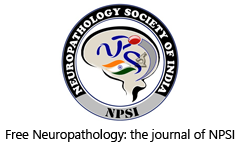Flashbacks


Just 40 years ago, Europe was divided into the Eastern communist bloc, which included the Czechoslovak Socialist Republic (ČSSR) and was dominated by the now historical Soviet Union, and the Western bloc comprising democracies such as Austria. The Iron Curtain, a heavily guarded and deadly border zone, separated the two blocs and constrained, in prison style, the populations of the Eastern bloc. The present neuropathological article relates the sad fate of František Faktor, a 33 years-old Czech who was shot by ČSSR border guards when attempting to flee to Austria at the border between Česke Velenice and Gmünd. František Faktor was found dead on November 5th, 1984, on Austrian soil some 500 meters from the border. ČSSR authorities claimed that he was shot when still within their territory, then ran some 900 meters to the other side of the border and died there. Neuropathology demonstrated a gunshot injury of the spinal canal, with transverse lesioning of the spinal cord predominating at Th10 that must have resulted in immediate paraplegia. This finding proved that ČSSR border guards had shot on Austrian territory, resulting in a major diplomatic éclat between both countries. After the implosion of the communist governments of the Eastern bloc in 1989, relations between Czechia and Austria started to normalise. By now, the Gmünd/Česke Velenice region has developed an exemplary good local neighbourhood and the former border has become virtually irrelevant. Attempts to bring justice have started in Czechia as well as other countries behind the past Iron Curtain and some former Czechoslovak officials held responsible for border killings were legally prosecuted. The present article demonstrates how a small medico-scientific discipline such as neuropathology can contribute to assess critical political events in our world.

The history of adrenoleukodystrophy (ALD), adrenomyeloneuropathy (AMN) and other peroxisomal diseases is exemplary for the stunning progress of scientific medicine within the past 50 years. Like many breakthroughs in medicine, the detailed analysis of patients’ pathologically affected tissues was instrumental, resulting in step-wise systematic clarification of what had remained enigmatic until the 1970s. This flashback paper is a recollection of the first neuropathological description of a slowly evolving clinical phenotype, spastic paraparesis with adrenal insufficiency, in a young adult by Budka et al. 1976 [3], using virtual microscopy of the original histologic slides. The clinico-pathological presentation derives from the classical cerebral ALD phenotype in boys, where electron microscopy demonstrated the underlying pathological hallmark of characteristic lipid inclusions shared by both phenotypes. Our report allowed the delineation of a new disease type almost simultaneously described in more cases as AMN by Griffin et al. 1977 [4] and Schaumburg et al. 1977 [11]. Moreover, our report indicated clinical heterogeneity in the ALD disease group that, as shown later, extends further to females, to Addison-only, and even to asymptomatic subjects. The gene underlying ALD was discovered in 1993 as a defect in the ABCD1 gene. Yet, it has hitherto remained unclear how the gene defect causes the strikingly broad and unpredictable phenotypic spectrum of ALD/AMN.
On February 23rd 1936, a boy-child (“Kn”) died in an asylum near Munich after years of severe congenital dis-ease, which had profoundly impaired his development leading to inability to walk, talk and see as well as to severe epilepsy. While a diagnosis of “Little’s disease” was made during life, his postmortem brain investiga-tion at Munich neuropathology (“Deutsche Forschungsanstalt für Psychiatrie”) revealed the diagnosis of “amaurotic idiocy” (AI). AI, as exemplified by Tay-Sachs-Disease (TSD), back then was not yet understood as a specific inborn error of metabolism encompassing several disease entities. Many neuropathological studies were performed on AI, but the underlying processes could only be revealed by new scientific techniques such as biochemical analysis of nervous tissue, deciphering AI as nervous system lipid storage diseases, e.g. GM2-gangliosidosis. In 1963, Sandhoff & Jatzkewitz published an article on a “biochemically special form of AI” reporting striking differences when comparing their biochemical observations of hallmark features of TSD to tissue composition in a single case: the boy Kn. This was the first description of “GM1-Gangliosidosis”, later understood as resulting from genetically determined deficiency in beta-galactosidase. Here we present illus-trative materials from this historic patient, including selected diagnostic slides from the case “Kn” in virtual microscopy, original records and other illustrative material available. Finally, we present results from genetic analysis performed on archived tissue proving beta-galactosidase-gene mutation, verifying the 1963 interpre-tation as correct. This synopsis shall give a first-hand impression of this milestone finding in neuropathology.

Jean-Martin Charcot described what he called amyotrophic lateral sclerosis in his 12th and 13th lessons published in 1873 by Bourneville. He distinguished the symptoms that were related to the lesion of the anterior horn of the spinal cord and those that were due to the degeneration (that he named “sclerosis”) of its lateral column. He thought that “inflammation” progressed from the lateral column to the anterior horn (but the term inflammation is not to be taken in the current meaning): the lesion of the anterior horn was thus “deuteropathic”. An album containing drawings made by Charcot is kept in La Salpêtrière Neuropathology Department. Four drawings are pasted on one of its pages, showing the degeneration of the pyramidal tract. They constitute the original of the engravings illustrating Charcot’s 12th lesson. The illustration of the fascicular atrophy of the adductor pollicis presented in the album does not appear in the lessons, even though this alteration is widely discussed and linked to the lesion of the anterior horn, which was supposed to ensure the “nutrition” of the muscle. The technique used by Charcot and his interpretation of the microscopic pictures, as exposed in his lessons, are discussed.
50 years ago back in 1971, David C. Taylor and colleagues from England reported on a small series of surgical epilepsy cases proposing a new type of tissue lesion as a cause of difficult-to-treat focal epilepsy: a localized malformation of cerebral cortex. The lesion is now known as focal cortical dysplasia (FCD) Type II or Taylor’s cortical dysplasia. FCD II is not rare, and today is a frequent finding in neurosurgical epilepsy specimens. Medical progress has been achieved in that the majority of FCD II is diagnosed non-invasively by magnetic reso-nance imaging today. Detailed studies on FCD revealed that the lesion belongs to a spectrum of mTOR-opathies, thereby confirming the authors´ initial hypothesis of a relationship to tuberous sclerosis. Here, selected original materials from Taylor´s series are presented as virtual slides, supplemented by original clinical records, in order to give a first-hand impression of this milestone finding in neuropathology of epilepsy.


















